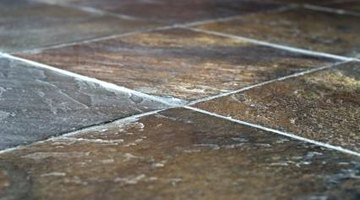How to Refinish Slate Floors
Slate floors are a durable floor surface with a wide color and texture range. These hard-working stones have been used in entryways for more than 50 years with the stone returning to popularity frequently.

The treatment of stone, particularly on floors, has changed over the last few years as better products have entered the market for consumers. Sometimes, old finishes must be stripped off, so that the stone and grout can be thoroughly cleaned and all spots, marks and stains can be lifted.
Things You Will Need
- Acetone stripping product
- Stripper for stone floors (your floor scrubber may require a special product)
- Rent a floor scrubber with a .46 grit silicon tynex brush
- 3-6 old towels
- Old paint brush
- Tape
- Plastic sheeting (drop cloth type)
- Nylon bristle brush
- Hand, eye and mouth protection
- Long sleeved shirt and pants
- *opt. Zip-Strip (for urethane finishes)
- *opt. Respirator for urethane removal
- Bucket and Mop
- Neutral pH Stone Cleanser
- Vacuum (canister type)
- 60-grit sandpaper
- *opt. penetrating color enhancer
- Acrylic Polymer sealer
- Distilled water
-
Remove any furniture, rugs and objects and vacuum your slate floor thoroughly to remove any grit or loose material.
-
Tape off the edges of your floor along baseboards and transitions to other types of floors. Roll your towels into logs and block sensitive areas (like transitions to carpet). (It is often a good idea to pull furniture away from the work area in adjacent rooms as well since the scrubber is a wet process and inexpert use may result in splatters. You can also tape plastic sheeting waist high across walls and doorways as an extra precaution.)
-
Wearing protection, liberally apply the acetone stripper to the grout lines using an old paint brush to presoak them.
-
Mix your stripper with water in the correct ratios (according to your scrubber manufacturer's directions). Plug in and activate your scrubber. It may hop about so hold on to it firmly. If necessary add additional towel logs along sensitive areas where your scrubber is bumping into.)
-
Scrub and strip your floor by moving the scrubber across the floor in even passes. After one pass, if you still see sealer or wax on the floor then strip the floor again from the from a different direction. This sometimes helps with the clefts in slate. Turn your scrubber off and dry the floor if needed. (Some scrubbers dry the floor at the same time.)
-
Scrub and strip the corners and along the edges by hand using your hand brush and the stripping product. Acetone is particularly good for stripping off waxy buildup and melting some sealer finishes. If your floor was sealed with urethane you may need to use Zip-Strip (follow their directions exactly as the product is aggressive and caustic). Use a 60 grit sandpaper for any residual sealer.
-
Mop your floor with a neutral pH stone specific cleanser and rinse with distilled water. Dry your floor immediately. If you want to add a color enhancer product, this is when you should apply it.
-
Vacuum your floor carefully to remove every bit of grit and dirt. Anything on the floor when you apply sealer will be sealed into the floor and grout.
-
Apply your finish sealer per the manufacturer's directions. This may take several coats depending on your product. Allow each coat to dry thoroughly before applying the next coat.
Tip
Slates, like all stone floors, are sensitive to minerals in water. Using distilled water will prevent your slate floor from acquiring water spots or mineral deposits. After your floor is refinished when you mop and rinse your floor with regular cleaning, be sure to use distilled water for your rinse and dry your floor immediately for the best appearance.
Warning
Some slates have inclusions of oxides which may rust or otherwise oxidize. Extra sealer is sometimes a good idea on spots where oxidation is a concern.
The Drip Cap
- Slate floors are a durable floor surface with a wide color and texture range.
- Roll your towels into logs and block sensitive areas (like transitions to carpet).
- ( It may hop about so hold on to it firmly.
- Some scrubbers dry the floor at the same time.) Scrub and strip the corners and along the edges by hand using your hand brush and the stripping product.
- Anything on the floor when you apply sealer will be sealed into the floor and grout.
- Apply your finish sealer per the manufacturer's directions.
References
Writer Bio
F.R.R. Mallory has been published since 1996, writing books, short stories, articles and essays. She has worked as an architect, restored cars, designed clothing, renovated homes and makes crafts. She is a graduate of the University of California at Berkeley with bachelor's degrees in psychology and English. Her fiction short story "Black Ice" recently won a National Space Society contest.
Photo Credits
- Filmwork istockphoto#2297956
- Filmwork istockphoto#2297956
More Articles



